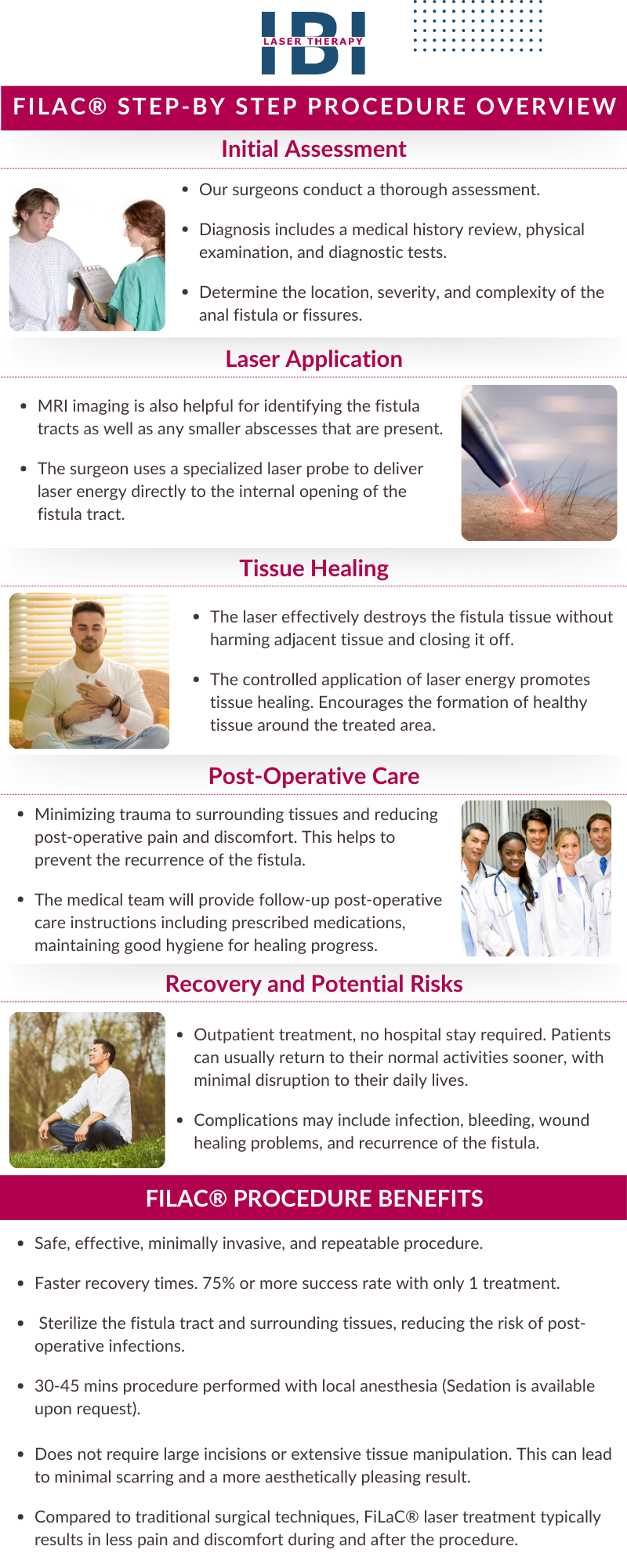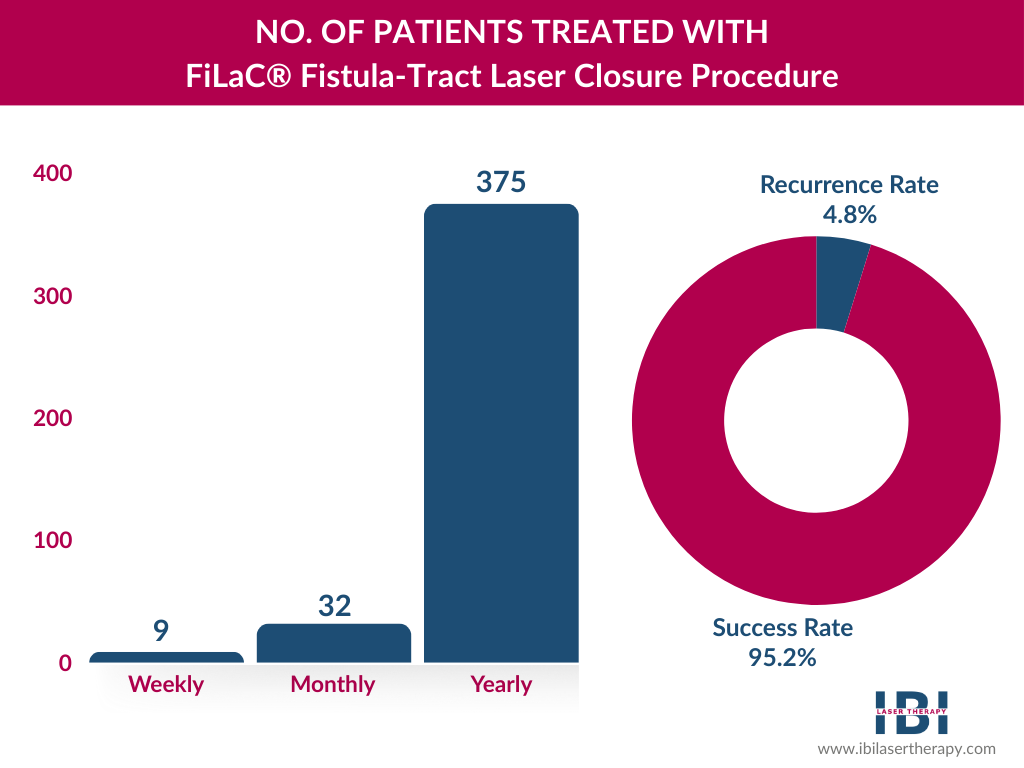Perianal Fistulas and Fissures Treatment FiLaC®
- Home
- /
- Our Services
- /
- Fistulas Fissures Treatment FiLaC®
Perianal Fistulas and Fissures Overview
Explore effective treatment options for Perianal Fistulas and Fissures, including medical interventions, lifestyle changes, and surgical procedures. In particular, fistula is an abnormal connection or passageway between two organs or vessels that don’t usually connect. Although, it can occur in the digestive tract, urinary tract, and reproductive organs. Whereas, a fissure is a small tear or cut in the lining of the butthole. Oftenly causing pain and bleeding during bowel movements.
As well as that, both result from infection, inflammation, or injury. Additionally, they can cause significant discomfort, pain, and complications if left untreated. Eventually, this leads to chronic infections, abscess formation, and tissue damage. Furthermore, timely and effective diagnoses and treatment can prevent risk factors from advancing.
Type of Perianal Fistulas and Fissures
Not only but also, treat a range of chronic and acute Perianal Fistulas and Fissures. Especially the common types:
- Enterovesical Fistula.
- Transphincteric Fistula.
- Intersphincteric Fistula.
- Enterocutaneous Fistula.
- Suprasphincteric Fistula.
- Extrasphincteric Fistula.
- Acute Anal Fissures.
- Chronic Anal Fissures.
Perianal Fistulas and Fissures Causes and Risk Factors
Although, anal fistulas typically result from clogged, infected, and abscessed anal glands. Although rare, conditions like the following can also cause anal fistulas:
Complications of Perianal Fistulas and Fissures if Left Untreated
Undeniably, early intervention can help control infection. As well as promote healing, and reduce the risk of recurrence. However, delaying treatment can lead to worsening symptoms, increased pain, and progressive tissue damage. In like manner, untreated Perianal Fistulas and Fissures may result in the formation of complex networks of passages. Thus, making them more challenging to manage surgically. Following are the Perianal Fistulas and Fissures symptoms and risk factors if left untreated:
Perianal Fistulas and Fissures Signs, Symptoms and Complications
Signs
- Emotional Distress.
- Bowel Obstruction.
- Recurrent Abscesses.
- Fecaluria or Pneumaturia.
- Drainage of Fluid or Feces.
Symptoms
- Chronic Pain and Discomfort.
- Fecal or Urinary Incontinence.
- Malnutrition and Dehydration.
- Chills, Fever, Fatigue, or Swelling.
Complication
- Recurrent Urinary Tract Infections.
- Discharge of Pus or Blood (around the opening of butthole).
Perianal Fistulas and Fissures Available Treatments
Henceforth, in the past, surgical treatment was the only way to treat fistulas. Not to mention, only 52% of patients had side effects like sphincter muscle damage leading to incontinence. Equally important, non-surgical treatments are effective and safe options. In the same way, to eliminate anal fistulas without surgery or any risk of damage to the sphincter muscle. In any event, a proctologist or medical specialist can usually determine the presence of fistulas by viewing the anal region.
Topical Medications
Creams or ointment containing steroids, or calcium channel blockers. Subsequently helps reduce pain and inflammation, and promotes healing temporarily.
Fistulotomy
Involves cutting open the fistula tract. Furthermore allows it to heal from the inside out. Although, the procedure is only effective for simple, low-risk and less severe fistulas with a single tract.
Fiber Supplements
Indeed, oral medications or stool softener supplements prevent constipation. Therefore, reduces strain during bowel movements, preventing further irritation.
Seton Placement
The silk or rubber placement through the fistula tract to allow drainage. However, effective for treating complex fistulas. But not sustainable for long term, particularly, for those who have high risk of recurrence.
Nitroglycerin
The ointment application relaxes the butthole area smooth muscles and improves blood flow. Henceforth, promotes healing and reduces the chronic pain.
FiLaC® Laser
FiLaC® (Fistula-Tract Laser Closure) is a minimally invasive procedure. Offers faster recovery compared to traditional surgical treatments with a reduced risk of recurrence.
Non-Surgical Perianal Fistulas and Fissures Treatment
The FiLaC® laser therapy removes the infected tissue as well as minimal tissue disruption. Nevertheless, at IBI Laser Institute, surgeons have a meticulous approach to treating complex and high-reoccurrence fistula and fissures.
FiLaC® Fistula-Tract Laser Closure Procedure
Similarly, eliminates the need to try tediously. To extract unwanted fistula tissue during a long complex surgery. In light of this, here’s our step-by-step procedure overview to ensure patients’ faster recovery with less pain and discomfort:

Conventional and Non-Surgical Treatments vs. FiLaC® Laser
Conventional Treatments
- Antibiotics, anti-inflammatory medication, drainage, and stool softeners only temporarily manage symptoms and prevent infection.
- As an alternative, surgeons may recommend it to help ease bowel movements and reduce strain on the affected area.
Surgical Treatments
- Open or traditional surgical treatments involve making incisions to access and remove the fistula tract.
- Eventually carry a higher risk of complications such as infection, bleeding, and incontinence.
- Following, longer recovery times require more time off work or regular activities. On the other hand, surgical incisions may result in visible scarring.
FiLaC® Laser Procedure
- FILAC laser treatment is a minimally invasive procedure that involves using laser energy to seal off the fistula tract.
- Despite this fact, the laser energy precisely targets the fistula tract, promoting effective closure and tissue healing.
- Because the treatment does not involve major surgery. After all, it carries a lower risk of complications. Oftenly results in less post-operative pain and discomfort.
- In the final analysis, patients experience faster recovery times compared to traditional surgical techniques.

Patient Testimonial
FiLaC® Procedure Cost and Insurance Coverage
Comparatively, on average, the treatment costs around $5,500 and $9,500$ per session. Depending on factors such as the fistula or fissure’s location and the condition’s severity. Although, it doesn’t include pre-operative consultations, diagnostic tests, anesthesia fees, facility fees, or post-operative medications. At this time, the IBI Laser Institute is running a promotional campaign, offering the FiLaC® procedure at a special price. However, it is subject to a limited period.
To emphasize, some insurance plans may cover a portion of the cost of treatment. Particularly if the procedure is medically necessary. At the same time, we offer CareCredit and Prosper Lending as alternative payment options. Nonetheless, call our patient experience team to check your coverage options.
